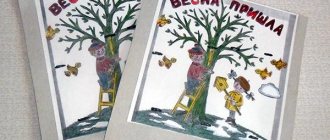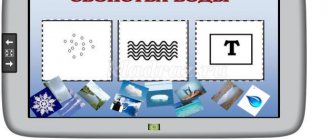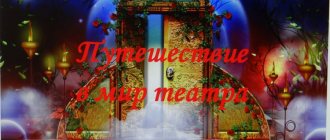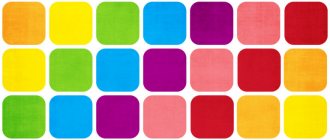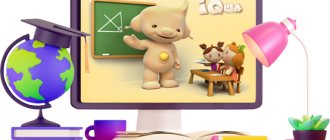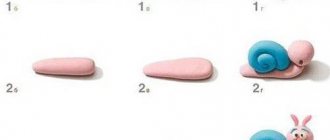Educational games for economic education of preschool children
Municipal autonomous preschool educational institution Child Development Center kindergarten No. 18 “Firefly” urban district of the city of Kumertau of the Republic of Bashkortostan
Educational games for economic education of preschool children
Prepared by the teacher
Khaliullina O.V.
2017
"Cafe "Tasty and Healthy"
Goal: to expand children’s knowledge about human needs for food, teach them to compare tasty and healthy products, and form the foundations of the economic culture of the child’s personality.
Material: menu with images of food products.
The teacher “invites” the children to the cafe. Each person has a menu with pictures of food items on their table. It is proposed to order the most delicious and healthy products, name them and compare which of them can be eaten often, which ones rarely and why.
"Tourist hike"
Goal: to clarify preschoolers’ knowledge about basic human needs.
Material: cards with pictures of different things.
Children are divided into three teams, each of which is preparing to go on a trip to the south, north, and into the desert. Teams can take only those things that they will need in the conditions in which they find themselves.
The items shown in the pictures are placed throughout the group room, and team members choose what they think they need most. At the end of the game, the teams check each other and explain their choices.
"Enterprises of our city"
Goal: to consolidate children’s knowledge about professions, to teach them to establish a relationship between the result of work activity and a person’s profession, to cultivate interest in people of different professions, and a respectful attitude towards them.
Material: photographs depicting workshops of various enterprises.
Children are given photographs depicting the workshops of city enterprises. They need to name the enterprise, the professions of the people working in it, and the products they produce.
"My Family Budget"
Goal: to expand children’s knowledge about the components of the family budget: salary, scholarship, pension; to form the foundations of the economic culture of preschoolers; cultivate respect for working people.
Material: cards depicting family members and the results of their work, money.
The teacher invites the children to divide into three families. Everyone needs to draw a card with a picture of family members, the result of their work. The amount of monetary reward for work is not indicated on the card; the children determine it themselves. Each family must determine its budget and at the end of the game compare who has it more. Family budget options may vary. For example, option 1: dad is a lawyer, salary..., mom is a salesperson, salary..., son is a student, scholarship...; option 2: dad is a driver, salary..., mom is a teacher, salary..., daughter is a 2nd grade student, etc.
"Warehouse"
Goal: continue to teach children to distinguish products according to their belonging to a certain group (furniture, clothing, shoes, household appliances, food, etc.).
Material: cards with images of goods, vans with the name of the stores where the goods will be delivered: “Shoes”, “Clothing”, “Food”, “Household Appliances”, “Furniture”.
The teacher invites children to act as delivery drivers and distribute goods using special vans to the appropriate stores: “Shoes”, “Clothing”, “Food”, “Household Appliances”, “Furniture”. Each delivery driver finds cards with goods for his store. The one who chooses the right product wins.
"Buying Tips"
Goal: to teach children to find a way out of the economic situation, to form the foundations of the economic culture of the child’s personality.
The teacher presents the children with various economic situations and asks them to resolve them. For each correct decision, a chip is given, and the one who collects the maximum number of chips wins.
Situation 1. When is it more profitable to buy a fur coat: in winter or summer? Why?
Situation 2. Apples were brought to the market. The seller Sveta received fresh, large apples with red sides, while the seller Kostya received small, wrinkled apples. They are priced the same. From whom will they buy apples faster?
Situation 3. The boy Misha decided to visit his sick grandmother and buy her bananas. In the store they cost 3 thousand, and in the market - 2 thousand. Where will Misha buy bananas? Why?
Situation 4. If milk prices become higher, what will happen to the prices of milk products?
Situation 5. When will apples and pears be cheaper: in summer or winter? Why?
Situation 6. What will the money be spent on: buying a car or a train ticket?
O. Prokofieva
Role-playing game on economics “The Good Fairy Store”
Target:
give children the opportunity to acquire what they want through purchase (through play action); teach how to choose a purchase, inventing the need for it for yourself; cultivate the ability to choose a purchase in accordance with the quality of its manufacture; to cultivate attentiveness, thrift, the ability to take an economical approach to choosing a product and purchasing a purchase; continue to enter the words sale, purchase into the active dictionary.
Equipment
: a doll in a blue dress, tickets for purchasing goods, goods in the form of homemade toys.
Preliminary work:
excursion to a flower shop.
The course of the role-playing game
IN.
Guys, we just recently were in a flower shop and bought flower seeds there. Well, does any of you remember the fairy tale “The Little Flower of Seven Flowers”? Yes, there were many miracles there! Would you like to find yourself in a fairy tale again? I thought that you would want to visit a fairy tale again. Today your wish will come true. A kind, wonderful Fairy invites you to her magic store.
The teacher shows a doll dressed in a beautiful blue dress and leads the children to the place where the Fairy's store is located. Through an audio recording, the Fairy addresses the children: “Hello, friends, I am very glad to welcome you to my store. Look carefully, what’s on sale?” (Children walk and carefully examine the product.)
IN.
Guys, since the Fairy’s store is magical, purchases here can only be made for special tickets, which the Fairy has prepared for you. But what a surprise! There were many more of you guys than there were tickets to buy. And therefore, the Fairy is forced to allocate only five tickets to each of you.
Therefore, you should choose those purchases that you really need. You can only make one purchase per ticket. How many purchases can you buy? Yes, that's right, only five. So now, when choosing a purchase, think about what you need to buy and what you will buy another time.
The teacher with the Fairy doll stands at the table where tickets are distributed for purchase. (The store also contains low-quality goods: a handbag with a torn handle, a torn napkin, etc.) The teacher monitors how the children choose their purchases.
During the game, the teacher invites the children to consult each other in choosing a purchase.
After the children have decided on the choice of goods, they evaluate it together with the teacher. The teacher clarifies whether the children are happy with the purchase. Next, everyone thanks the Fairy for the purchases. The teacher invites the children to examine the defective goods. Clarifies why no one bought these goods.
The fairy notes that these goods will be returned to the factories to eliminate the defects.
After the children discovered low-quality products, the Fairy explains to them that she specifically asked for this product to be brought unfinished in order to teach the children to be attentive when purchasing and to be able to evaluate a product based on the quality of its workmanship.
Economic game for children “Shop”
The purpose of the economic game:
to expand children’s understanding of what a store is;
give a new concept of “product”,
food and industrial products,
price;
types of stores;
consolidate children's knowledge of what money is needed for;
foster a culture of relationships between seller and buyer.
Progress of an economic game for children
V.
Guys, we know a lot about the history of money: how it appeared, what it was used before instead of money, what kind of money exists now in different countries.
The teacher repeats and reinforces with the children already familiar material on the topic: “Money and the history of its origin.”
IN.
What is a store? (Children's answers.) That's right, this is the place where people shop. What can you buy in the store? (Children's answers.) Who knows how to describe in one word everything that is sold in the store? (Product.) This means that a product is everything that is sold in a store.
Guess the riddle:
Guess what it's called
What money is being sold.
It's not a wonderful gift
But simply... (Product.)
Name food products, i.e. goods that can be bought in a store and eaten. (Bread, milk, eggs, candy, etc.)
Now try to name industrial goods (clothing, shoes, hats, etc.). (Children's answers.)
So, what kind of products do we have? (Food and industrial.)
Think, guys, what a buyer needs to have and what he needs to know in order to buy a product. (Have money, know the price.) What is price? (This is how much the product costs.) Is the price of the product always the same? (No.) This means that goods can be cheap and expensive.
Tell me, is it profitable for a buyer to buy a cheap product? Is it profitable for the seller to sell cheap goods?
This means that price affects how much of a product you can buy. (There are many cheap products, few expensive ones.)
Which product would you buy - cheap or expensive? Why?
Guys, on the one hand, it’s right when you save money by buying a cheap product, and you still have money left for another purchase. This is good.
But such a situation may also exist. For example, a store sells shoes.
One pair of shoes is cheap, but the quality is not very good, meaning they are not as comfortable. There is no guarantee that it will last long. In addition, these shoes are only available in large sizes.
The second pair of shoes costs more, but they are very comfortable and practical. This pair of shoes is made by a reputed company and is made from quality materials and its quality is guaranteed.
Which shoes would you buy - the one that is cheaper but of poor quality or the one that is more expensive but of higher quality? (Children's answers.)
It is necessary to draw children's attention to the fact that it is good to buy cheap goods, but it is also important to pay attention to the quality of the products. Sometimes, as you can see, it makes sense to buy an expensive, but higher quality item.
IN.
We have already found out that there are food products, and there are industrial goods. What kind of stores do we have? (Vegetable, bread, sausage, fish - food stores; furniture, shoe, "Clothing", etc. - industrial goods stores.)
What are the people called who work in a store and sell goods? (Sellers.) And those who buy these goods? (Buyers.)
What is the job of a store salesperson? For example, in a grocery store? And in a store that sells ribbons, buttons, fabrics? What about in a shoe store? (Children's answers.) Would you like to become a salesman in a store? (Children's answers.)
The teacher invites the children to play the role-playing game “Shop”. Draws attention to the culture of relationships between seller and buyer.
Didactic games in economics
"Cash flow"
Purpose of the game: to develop children's understanding of money; skills for effective personal money management; interest in acquiring and further deepening financial knowledge, which will help achieve success in adult life.
"Monopoly"
The goal of the game is to earn the most money by the time one of the players goes bankrupt. To make money, you need to place your ticket booths on sectors of attractions and sell tickets (analogous to taxes) when other players find themselves on these fields.
"My Family Budget"
Goal: to expand children’s knowledge about the components of the family budget: salary, scholarship, pension; to form the foundations of the economic culture of preschoolers; cultivate respect for working people.
"Who's doing what?"
Goal: To expand children's knowledge about professions and work activities; to cultivate interest in new professions and respect for the work of adults.
Material: Cards depicting a profession (salesman, cook, cashier, artist, banker). Labor action (weighs goods, prepares food, draws, talks, counts out money, shows advertising samples, etc.)
Contents: The child, taking the card, names his profession. Finds the corresponding card with the image of labor actions and talks about them.
Option. Children select tools (pictures) that are necessary for the work of people of those professions that are depicted in the plot pictures.
“Name the professions”
Target. Teach the child to establish a relationship between the results of work activity and a person’s profession. Cultivate an interest in people of different professions.
Material. A chamomile flower, the petals of which conventionally depict the results of the work of people of different professions.
Content. A child, tearing off a chamomile petal, names a profession related to satisfying a specific need.
"Who works, who plays"
Target. To consolidate children’s ideas about the difference between work and play activities (work - non-work).
Material. A set of cards depicting work and game processes.
Content. Each child has a set of paired cards (work - play activities). The child describes the images, names the processes (a boy cleans a shoe, a girl washes doll clothes, children dance, play, etc.). Establishes differences (the presence of a result of labor or its absence).
“What kind of income are there?”
Target. Clarify children’s knowledge about basic and additional incomes; improve skills in independently determining types of income (basic and non-basic).
Material. Cards depicting the main activities for which adults receive their main income - wages (work of a hairdresser, doctor, carpenter, carpenter, weaver, etc.). And types of activities aimed at obtaining natural products (picking berries, mushrooms, working in the garden, vegetable garden, etc.), providing additional income.
Content. Children look at the cards, name the activities of the adults, the result obtained, and highlight the main and additional incomes.
"Freight train"
Target. Strengthen children's knowledge about the place of manufacture of goods; classify goods by place of production
Material. Cards with an image of a product, a flat image of a freight train with wagons.
Content. Children arrange goods among the carriages so that each contains goods that are identical in place of production. For example, meat products are products of a meat processing plant, dairy products are products of a dairy plant, etc.
Option. Children group objects by place of production: furniture - furniture factory, dishes - earthenware factory, toys - toy factory, etc.
"Product routes"
Target. To develop in children the ability to distinguish goods according to their belonging to a certain group (household appliances, industrial goods, furniture, agricultural products, etc.)
Material. Pictures depicting goods or real objects and toys, signs with the names of stores: “Clothing”, “Furniture”, “Household Appliances”, “Agricultural Products”, etc.
Content. Each child chooses a picture card, names what is drawn on it, and determines which store this product can be taken to. The winner is the one who correctly matches the cards to the signs with the name of the store.
"Guess where they sell"
Target. Teach children to correlate the name of the store with the goods that are sold in it; develop the ability to generalize groups of objects.
Material. Pictures depicting vegetables, fruits, furniture, shoes, etc.
Content. Children select groups of cards with images of vegetables, fruits, furniture, etc. Lay them out in front of the corresponding plot picture, where the stores “Furniture”, “Vegetables”, “Supermarket”, etc. are drawn. Establish a relationship between the name of the store and the goods that are in they are sold there.
“What will they buy faster?”
Target. Develop the ability to establish a relationship between the quality of a product, its price (cost) and demand for it.
Material. Cards with images of high-quality and low-quality goods (dresses for a doll, one of them is missing several buttons; toy cars, one of them has headlights of different colors; boots, one of them has no lace).
Content. The child is offered a pair of cards depicting identical products. Of the two items offered, the child chooses the one that will be bought faster and explains the reason for his choice.
“What and when is the best time to sell?”
Target. To consolidate children's knowledge about the demand for goods, about the influence of the seasonality factor (time of year) on real demand.
Material. Cards depicting a store and its environment at different times of the year (summer, winter, etc.); small cards depicting seasonal products.
Content. Children stock the shops with seasonal goods. For example: Panama hats, sandals, sundress, badminton, etc. - to the “summer” store. Fur coat, hats, mittens - in “winter”.
"Domino"
Target. To consolidate knowledge about the name and denomination of coins; develop attention and memory.
Material. Domino cards with coins of different denominations and in different sets.
Content. The rules of the game are common to dominoes. One of the children puts out a domino card, the next child on the left or right puts down a card with the corresponding “set” of coins. At the end of the game, a check is carried out to determine whether the cards have been selected correctly.....
Option. The domino cards feature banknotes from different countries.
Target. Develop the ability to navigate the price of goods, set the range of items (goods) by price; develop independence in choosing a solution.
Material. Cards with images of various items, price tags.
Content. First, children select items of goods (serial rows) from the cheapest item to the most expensive item and vice versa. Children compare prices, find different and identically priced items.
"Name the Coin"
Target. Expand children's understanding of the variety of names for money in works of art.
Material. Fairy tales “Baby and Carlson”, “The Adventures of Pinocchio”, “Ali Baba and the Forty Thieves”, etc. “Portraits” of fairy-tale characters..
Content. Children look at the illustrations and remember the content of fairy tales. Through a game situation, the name of the money used by the heroes of fairy tales is determined. For example, Carlson buys a puppy for Baby, having several eras. Pinocchio buys a theater ticket for four soldiers. Ali Baba and the Forty Thieves own dinars, etc.
“I want and need”
Goal: to introduce children to the diversity of needs and disabilities. Learn to determine the difference between “want” and “need”.
Material: cards depicting a house, clothing, food, water, cat, dog, bicycle, sweets, ice cream, car, doll, computer, TV, flowers, etc.; playing field.
Content. determine which concept—“I want” or “need”—the object depicted on the cardboard refers to, and glue the picture to the corresponding panel.
"Money box"
Purpose: to give an idea of the accumulation of funds.
Material: “piggy banks” and coins of different denominations.
Contents: choose coins of different denominations so that their total is: for the first piggy bank - 5 rubles, for the second - 10.
“What kind of income are there?”
Target. Clarify children’s knowledge about basic and additional incomes; improve skills in independently determining types of income (basic and non-basic).
Material. Cards depicting the main activities for which adults receive their main income - wages (work of a hairdresser, doctor, carpenter, carpenter, weaver, etc.). And types of activities aimed at obtaining natural products (picking berries, mushrooms, working in the garden, vegetable garden, etc.), providing additional income.
Content. Children look at the cards, name the activities of the adults, the result obtained, and highlight the main and additional incomes.
Card index of didactic games with economic content.
Transcript
1 Card index of didactic games with economic content. 1. “WHAT ARE THE EXPENSES” GOAL: To show children that there are mandatory (basic) and optional (non-basic) expenses. MATERIAL: “Expenses” model, cards with images of items symbolizing basic and non-basic expenses (furniture, clothing, food, food, electricity, gas, toys, books, white and red cards. PROCEDURE. Option 1: presenter shows a picture with the image any object, the children raise a card of the color that he considers the object to be according to the degree of need. Option 2: children are given object pictures, cards are given to two children. At the teacher’s signal, the children stand around the child of the color they think is necessary. 2. “SMALL SHOPPINGS" PURPOSE: Show that each thing costs money, compare the price of the product with the available cash. MATERIAL: Pictures depicting various items (products), price tags, money. PROCEDURE: Children choose a product, compare the price with the money they have, make purchases according to the instructions of the presenter: -Purchase of only one item (product) -Buys several products at once (demand does not exceed supply).
2 -The buyer compares goods by cost (more expensive, cheaper, the same price) 3. “INTERESTING SHOPPING” GOAL: To reveal to children the purchasing power of banknotes. MATERIAL: Goods of different values, coins (bills) of different denominations. PROCEDURE: The presenter gives tasks to the “buyers” with gradual complication: -buy a thing (item) that costs rubles; -name what you can buy for..rubles; -find out on your own and then name one, two, three things that cost a certain amount of money. 4. “KNOW THE PRODUCT” PURPOSE: To give the concept that each item-product.products have different purposes. MATERIAL: Pictures depicting goods for various purposes (industrial, agricultural, cultural and domestic purposes, etc.) PROCEDURE: Option 1: The buyer describes the product without naming it, the seller guesses and gives it back. Option 2: The buyer names the purpose of the item or some actions with this item, the seller guesses and gives it back. Option 3: The buyer names what can happen 5. “WHOSE’S SOUVENIR” Purpose: To introduce children to folk crafts (Gorodets,
3 Khokhloma, etc.) MATERIAL: Picture puzzles. PROCEDURE: Option 1: Children are offered puzzles depicting various folk crafts. The presenter shows the picture; the children determine who has what trade and put together the puzzles. Option 2: Children independently choose puzzles from the same craft. Option 3: The presenter names a craft, children find images of products from this craft. 6. “Children's lottery” Purpose: To introduce children to the features of playing the lottery. Material: Lottery tickets indicating the number and series; special prizes (children's crafts); scoreboard. PROCEDURE: A lottery is an opportunity to win something with purchased lottery tickets. Children buy tickets, and then everything is played out like in a real lottery. The drum with balls spins, and the number of the ticket on which the winnings “fell out” is announced. Children compare the ticket numbers with the numbers on the scoreboard. This is a win-win lottery. 7. “Guess what profession this is” GOAL: To consolidate and clarify children’s knowledge about professions related to working in an advertising agency. MATERIAL: Picture cards depicting people of different professions. PROCEDURE: Option 1: The teacher describes the professions of an advertising agent, advertiser, graphic designer, etc., but does not name them. Children guess. Option 2: Game with cards depicting: bank, kindergarten,
4 advertising agency, hospital, store, etc. The children are given cards and they say what the people working, for example, in the hospital do. 8. “Who does what?” GOAL: To expand children's knowledge about professions and work activities; to cultivate interest in new professions and respect for the work of adults. MATERIAL: Cards depicting a profession (salesman, cook, cashier, artist, banker) and labor action (weighing goods, preparing food, drawing) PROCEDURE: The child, taking a card, names the profession. Finds the corresponding card with the image of labor actions and talks about them. Option: Children select tools (pictures) that are necessary for the work of people of those professions that are depicted in the plot pictures. 9. “NAME YOUR PROFESSIONS” GOAL: To teach a child to establish a relationship between the results of work activity and a person’s profession; to cultivate interest in people of different professions. MATERIAL: Chamomile flower, on the petals of which the results of the work of people of different professions are conventionally depicted. PROCEDURE: The child, tearing off a chamomile petal, names a profession related to satisfying a specific need. 10 “WHO WORKS, WHO PLAYS” GOAL: to consolidate children’s ideas about the difference between work and play
5 activities (labor non-labor). MATERIAL: a set of cards depicting game and work processes. PROCEDURE: Each child has a set of paired cards (labor play activity). The child describes the images, names the processes (a boy cleans a shoe, a girl washes doll clothes, children dance, play, etc.), establishes differences (the presence of a result of labor or its absence). 11 “WHAT ARE THERE ARE INCOMES” GOAL: To clarify children’s knowledge about basic and additional incomes; improve skills in independently determining types of income (basic and non-basic). MATERIAL: Cards depicting the main types of activities for which adults receive their main income (wages), and types of activities aimed at obtaining natural products (picking berries, mushrooms; working in the garden, vegetable garden, etc.) that provide additional income. PROCEDURE: Children look at the cards, name the activities of adults, the result obtained, highlight additional and main incomes. 12 “FREIGHT TRAIN” GOAL: To consolidate children’s knowledge about the place of manufacture of goods; classify goods by place of production. MATERIAL: Cards with images of goods, a flat image of a freight train with wagons. PROCEDURE: Option 1: Children lay out the goods among the carriages so that each contains goods that are identical at the place of production. For example, meat products produced by a meat processing plant, dairy products produced by a dairy plant. Option 2: Children group items by place of production:
6 furniture furniture factory, tableware earthenware factory, toys toy factory. 13 “GOODS ROUTES” GOAL: To develop in children the ability to distinguish goods according to their belonging to a certain group (household appliances, industrial goods, furniture, agricultural products, etc.). MATERIALS: pictures depicting goods or real objects and toys, signs with the names of stores: “Clothing”, “Furniture”, etc. PROCEDURE: each child chooses a picture card, names what is drawn on it, and determines which store this product can be taken to. The winner is the one who correctly matches the cards to the signs with the name of the store. 14 “GET IT TOGETHER” GOAL: To expand children’s understanding of products; teach how to group them according to different characteristics. MATERIAL: Map (panel) depicting various products. PROCEDURE: Each child has a card. On which various objects are drawn. Using Euler Venn circles, children combine objects according to various criteria: edible and inedible; toys tools. 15 “GUESS WHERE THEY ARE SOLD” (A) GOAL: To teach children to correlate the names of the store with the goods that are sold in it; develop the ability to generalize groups of objects. MATERIAL: Pictures depicting vegetables, fruits, furniture, shoes, etc. PROCEDURE: children select groups of cards depicting vegetables, fruits,
7 furniture, etc. They are laid out in front of the corresponding plot picture, where the stores “Furniture”, “Vegetables”, etc. are drawn. They establish a relationship between the name of the store and the goods that are sold in it. 16 “TOY STORE” GOAL: To give children the opportunity to practically carry out the buying and selling process; develop the ability to “see” a product: material, place of production, price (cost). MATERIAL: Various toys, price tags, trademarks, play money. PROCEDURE: Before buying a toy he likes, the child names the material from which it is made (wood, metal, plastic, fabric, etc.), the place of production (where and who made it). Next, the price of the toy is determined. The child counts out a certain amount of money and buys a toy. As toys sell out, the seller adds new ones. 17 “WHAT WILL THEY BUY FASTER?” GOAL: To develop the ability to establish a relationship between the quality of a product, its price (cost) and demand for it. MATERIAL: cards with images of high-quality and low-quality goods (a dress for a doll, one of them is missing several buttons); boots (one has no laces). PROCEDURE: The child is offered a pair of cards depicting identical products. Of the two items offered, the child chooses the one that will be bought faster and explains the reason for his choice. 18 “WHAT AND WHEN IS IT BETTER TO SELL?” GOAL: To consolidate children’s knowledge about the demand for a product and the influence of the factor
8 seasonality (time of year) on real demand. MATERIAL: Cards depicting a store and its environment at different times of the year (summer, winter, etc.); small cards depicting seasonal products. PROCEDURE: Children fill the stores with goods according to the season. For example, Panama hats, sandals, a sundress in a “summer” store. 19 “DOMINO” GOAL: To consolidate knowledge about the name and denomination of coins; develop attention and memory. MATERIAL: domino cards with coins of different denominations and in different sets. PROCEDURE: The rules of the game are common for dominoes. One of the children puts out a domino card, the next child, on the left or right, puts a card with the corresponding “set” of coins. At the end of the game, a check is carried out to determine whether the cards were selected correctly. Option. The domino cards feature banknotes from different countries.
9

